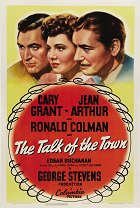Director:
George StevensCámara:
Ted TetzlaffMúsica:
Friedrich HollaenderReparto:
Cary Grant, Jean Arthur, Ronald Colman, Edgar Buchanan, Glenda Farrell, Charles Dingle, Emma Dunn, Rex Ingram, Tom Tyler, Don Beddoe, Dan Seymour (más)Streaming (1)
Sinopsis(1)
Grant stars as Leopold Dilg, a political activist who is wrongly indicted for arson and murder when a factory worker dies in a mill fire in the town of Sweetbrook. Believing that he'll be executed if he remains in jail, he escapes and breaks into a cottage that schoolteacher Nora Shelley (Jean Arthur) is preparing for Professor Michael Lightcap (Ronald Coleman), the dean of a law school. She allows Grant to stay in the attic, without alerting the professor. The next day, a reporter arrives to question Lightcap about Dilg's case, along with Sam Yates (Edgar Buchanan), Dilg's lawyer, who comes at Nora's behest. Since Yates and Lightcap know each other from law school, Yates asks Lightcap's help in defending his client, who he claims to have been framed. The professor refuses, intent on writing a legal treatise. Before Yates leaves, he persuades Nora to house Dilg, who she introduces to Lightcap as a gardener. Before long, the professor begins to realize that the gardener is well versed in the intricacies and inequities of the U.S. legal system. (texto oficial de la distribuidora)
(más)Reseñas (1)
The unusual informational density of the prologue gives the impression that The Talk of the Town did not begin in medias res, but rather after everything had already happened. Besides the ongoing events of work, nearly half of the footage consists in questions pertaining to events of the past, summarised in the introduction without any explanation of the context. Director Georges Stevens does not make it easy for us to get into the story. He does not provide a pause in order to clarify everything that has happened by means of an explanatory monologue or flashback. (By postponing the moment of revelation, which actually never happens, we are constantly held in a state of suspense, which is also helped by the casting of Cary Grant, whose unreadability was used masterfully by Hitchcock in Suspicion a year prior). Quite the contrary – it adds to the twists and involves new characters in the story, which reaches an absurd dimension in a scene where perhaps half of the city meets in a single room. Only then comes clarification and the narrative is more or less limited to two men and one woman until the end. The female character in particular gives a significant comedic touch to the film, which began as a crime thriller. The fact that the stereotype of a scatter-brained and dependent woman is intentionally fulfilled in order to divert attention away from the presence of a man in hiding is humorous (and subversive). It also remains less estimable for the rest of the film, though her chaotic manner is motivated by the requirement of the narrative, which someone has to keep going. The frantic screwball pace slows only in the final third of the film, which gives more space to the storyline focused on the court proceedings and to the professor. The shots are longer, the alternating of angles and lengths of shots less frequent, i.e. in accordance with the nature of the topics addressed and the necessity of order in life. The form of The Talk of the Town is essentially determined by the nature of the two potential fiancés of the female lead, one level-headed and one spontaneous. Weaving between two genres allows Stevens to constantly circumvent our expectations, leaving them unfulfilled, as we do not know with any certainty in which genre to place the film. The result brings to mind two films (self-effacing and melodramatically serious) squeezed into each other. That is remarkable yet, at the same time, unconvincing and not fully satisfying in any genre. 75%
()

